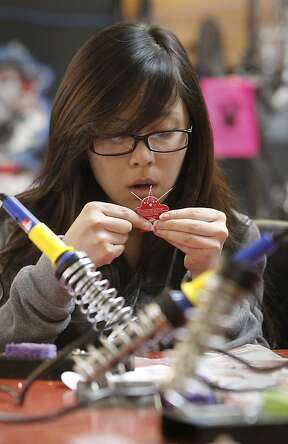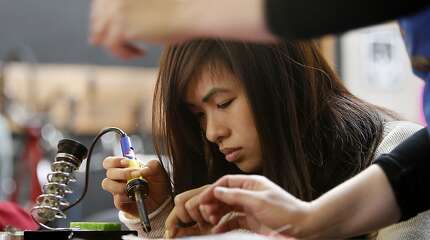April 8, 2013 | SF Chronicle
 |
Michael Macor, The Chronicle
Volunteer teacher Jarrod Hicks (left) shows Burton High students the results of a computer-aided laser cutting design.
|
Zertuche, a metrology engineer, worked on space telescopes before becoming a physics teacher at Phillip & Sala Burton Academic High School in San Francisco's Portola district this year. She wants students to see that science is not just in textbooks, but also in their phones, computers, video games and pretty much everywhere they look.
So her students this year are learning about energy transference, resistors and capacitors, and then building water bottle rockets, solar model homes and circuit boards. They also solve equations, have homework and take tests.
It's exactly kind of book-smart and hands-on combination envisioned for all academic subjects in the new Common Core standards adopted by California and most other states, which are in the early stages of implementation in San Francisco and other districts.
The new standards will replace what has been described as a mile-wide, inch-deep curriculum that gives students a basic knowledge about a lot of topics, but not always a lot of deep understanding of how those topics apply or work real world situations.
Getting creative
With the Common Core's best-of-both-worlds philosophy in mind, Zertuche took her physics students on the field trip to Noisebridge on Mission Street - otherwise known as an "anarchistic educational hackerspace."
Think MythBusters meets Burning Man.
 |
Michael Macor, The Chronicle
Burton High student Gloria Chan works on her flashing LED light project at Noisebridge.
|
Noisebridge is open 24/7 to anyone who wants to use the random electronic equipment, power tools, painting supplies, 3-D printers, and pretty much anything anyone would need to make a robot or a kitchen table. If something is lying around, you can use it, change it or take it apart.
Volunteer teachers
Some Noisebridge regulars offered their know-how to Zertuche's classes for the day, teaching students how to solder a small circuit, turn a computer image into a printed plastic medallion, bust open a portable piano keyboard and fiddle with the wiring, and create video games.
The physics behind the activities included electromagnetics, circuit flow, energy transference, and the use of resistors and capacitors - topics the students had learned in class using symbols and formulas and calculations.
At a soldering table, Alyanna Gregorio, 16, held up a piece of plastic with silver wires sticking out and two blinking lights.
"Oh my God!" she yelled. "I made this!"
 |
Michael Macor, The Chronicle
Twelfth grader Jamie Guan, builds her
LED flashing light project as students from Burton High School get a
hands on experience in electronics and physics at Noisebridge, in San
Francisco, Ca. on Tuesday April 2, 2013. Noisebridge is an
infrastructure provider for technical-creative projects, collaboratively
run by its members as a non-profit educational corporation for public
benefit.
|
"In school we take notes and read books and it isn't fun," Alyanna said. "This is fun."
Nearby another group of students huddled around a table with electronic piano keyboards in various states of disassemble.
Noisebridge volunteer Martin DeVido, 23, described the process of "circuit bending."
The idea, he said, was to repurpose old and obsolete electronics and make new things.
"It involves opening up stuff," he said. "It's like dissecting a frog and creating a new monster."
On the table were keyboards with their capacitors, resistors and circuit boards splayed and their innards tinkered with to make weird sounds.
He encouraged the students to be adventurous and creative in playing with stuff that that is basically just science in the form of a machine or a musical instrument.
"They can be creators and not know what they're doing to be learning," he said after the students had left for another activity. "I never learned what a capacitor was until I blew one up."
Jill Tucker is a San Francisco Chronicle staff writer. E-mail: jtucker@sfchronicle.com